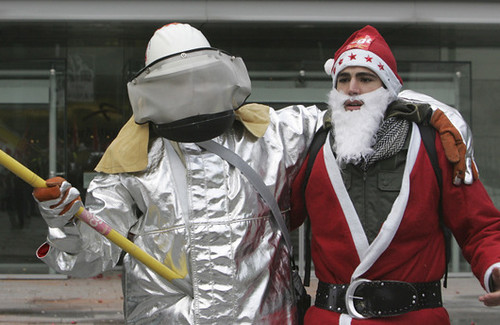Move Your Stock Price

Play it again, Romain. Our favorite satcom CEO, Romain Bausch of SES, is making the rounds this month (click for webcast). Talking to bankers and analysts about his company’s strong financial performance currently and beyond. He’s just trying to move the stock price. Yeah, good luck with that The Really Rocket Science Stock Index seems to be doing OK.
Now I doubt this is sufficient cause for civil unrest in the streets of Luxembourg. But it is enough for Peter de Selding of Space News to call them on it:
Satellite fleet operator SES is rethinking its strategy with respect to its biggest rival, Intelsat, in light of Intelsat’s recently demonstrated ability to maintain a global presence despite its huge debt load and its owners’ ultimate goal of cashing out of the business, SES officials said May 19.
In presentations to investors in London, SES officials reiterated their view that, over time, SES’s stable investor base and moderate debt load will enable it to outlast Intelsat in regions that, while profitable, would exhaust Intelsat’s capital expenditure limits.
In these cases, they said, SES will be ready to use its financial strength to establish satellite beachheads in markets currently dominated by Intelsat.
SES Chief Executive Romain Bausch went so far as to say the eventual disposition of Intelsat assets as its current private-equity owners seek an exit will be more important than the current global economic crisis in shaping the commercial satellite telecommunications landscape in the coming years.
"It is not the crisis that will determine what will go on in our industry in terms of concentration," Bausch said of a possible reshuffling of satellites assets worldwide.
"The main driver of concentration in our industry will [be] the need of the current owners of the large satellite operators. To be very clear: Intelsat is today capital constrained because of its LBOs [leveraged buyouts, which loaded the company with debt]. There is only one objective of the current owners of Intelsat: to prepare a profitable exit from that business. They are private-equity funds and their mission is not to remain shareholders of a satellite operator for 10 years.
"So there might be consolidation in our sector because of the shareholders of one of the two large satellite operators — namely Intelsat — having to exit. This is much more important for the discussion about landscape and concentration than the current crisis."
Notwithstanding this strategic assessment, Bausch said Luxembourg-based SES is rethinking its short-term assumptions following a couple of deals Intelsat put together. Intelsat’s New Dawn satellite, being built with South African partners, will require little capital outlay by Intelsat. The IS-22 satellite to be deployed over the Indian Ocean, meanwhile, is being financed largely by the Australian Defence Force in exchange for a UHF-band payload that Australian forces will use for mobile communications.
Bausch said that in 2008, SES compiled an internal assessment forecasting that its in-orbit capacity would grow by 4 percent annually. The same forecast concluded that Eutelsat of Paris would increase its in-orbit transponder capacity by 2.5-3 percent annually, while Intelsat would reduce its in-orbit fleet by some 2.5 percent a year.
SES now concludes that with the "very creative financing" Intelsat has demonstrated, "they may not go for such an important decrease in the capacity they will offer. So we will probably have to revisit our model and to be less aggressive regarding Intelsat shrinking its satellite capacity. But still, they will not increase capacity."
SES is in the middle of a substantial fleet-expansion program that will add more than 20 percent to its current in-orbit transponder capacity in the coming years from satellites already under construction.
Robert Bednarek, president of SES Americom New Skies, one of two SES divisions — SES Astra is the other — that divide up the world from a satellite-market perspective, said SES is "not sure we can discern a strategy [at Intelsat] yet. It obviously relates to the long-term plans of the current private-equity holders."
Bednarek said Intelsat is likely to conclude more deals similar to New Dawn, where a money-making satellite nearing retirement is replaced through a partnership that permits Intelsat to avoid digging deeply into its own pockets.
New Dawn and IS-22, Bednarek said, are "essentially someone else financing a replacement. … I would expect that process — an our-slots-your-money approach of financing either replacement satellites or fresh satellites — to continue. We certainly haven’t anticipated them disappearing from the market, by any stretch."
BC Partners Holdings Ltd., Intelsat’s lead investor, has said it is willing to stick with the investment over the long term. Intelsat Chief Executive David McGlade in recent months has said the company’s owners have been willing to permit selected investments in growth opportunities despite Intelsat’s large debt.
SES and Intelsat of Bermuda and Washington are by far the world’s largest commercial satellite fleet operators, with market shares in 2008 of 25.1 percent and 24.7 percent, respectively, according to SES estimates.
SES assumes that the global market for Ku-band satellite capacity will grow by 4.5 percent per year between now and 2016, while the C-band market will grow by 2.4 percent annually.
Trashing your competitor is not going to win you business. Good service and reasonable pricing will.
